By Jonathan Simon In plumbing, like many trades, knowledge is often shared plumber-to-plumber in the field. That allows experience to get passed from one generation to the next. But sometimes the information shared doesn’t keep up with new developments or, like a childhood game of “telephone,” gets distorted over time and becomes inaccurate. The result Read more
ShopTalk

By Jonathan Simon
In plumbing, like many trades, knowledge is often shared plumber-to-plumber in the field. That allows experience to get passed from one generation to the next. But sometimes the information shared doesn’t keep up with new developments or, like a childhood game of “telephone,” gets distorted over time and becomes inaccurate. The result is the proliferation of “myths” that are accepted as true by some but are provably false. Here are five myths related to CPVC plumbing systems that the FlowGuard Gold® CPVC team has encountered in the field–and the truth behind the myth.
Myth 1: CPVC should be replaced when it shows signs of discoloration
It’s easy to see how some myths get started. A plumber may think that discoloration is an indication of structural weakness, decides the pipe needs to be replaced and passes that “tip” onto a younger plumber.
But older CPVC pipes that show signs of discoloration do not need to be replaced. CPVC naturally becomes more rigid as it ages and may discolor, but these factors do not increase the risk of failure in a properly installed and serviced system. In fact, the pressure-bearing capability of CPVC pipes improves with age, so, by that measure, an older CPVC pipe is actually stronger than it was when first installed.
It is recommended that plumbers use C-style cutters, a wheel cutter, or a fine-tooth saw when servicing older CPVC pipes, but there is no reason to remove the pipe from service due to discoloration. One of CPVC’s strengths is the material’s long service life—some of the first CPVC pipes ever installed back in the 1960s are still in service today–and discoloration is not a reason to shorten that service life.
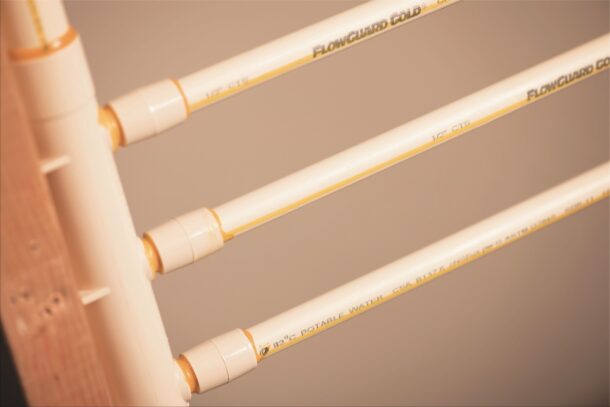
Myth 2: CPVC is difficult or slow to install
Some myths are rooted in misperceptions and false assumptions while others can be traced to competitors seeking to gain traction in a competitive market. The myth that CPVC is difficult to install falls into the second category.
CPVC plumbing systems are similar to copper in their design. Both are rigid systems that use socket-style fittings in which the pipe fits into the fitting. But CPVC is easier to work with than copper and the solvent welding process used to bond CPVC pipes and fittings is simple, easy to learn and does not require any special tools. CPVC plumbing systems install faster than copper and have installation times that compare favorably to PEX systems.
Independent research studies that measured installation times for CPVC and PEX systems found that CPVC trunk-and-branch systems install up to 17% faster than comparable PEX trunk-and-branch systems. A PEX mini-manifold system installed 10% faster than a CPVC trunk-and-branch system but used 21% more pipe and the added material costs outweighed the time savings. Most plumbers with experience using both materials have reported no noticeable speed difference between CPVC and PEX plumbing systems.
Myth 3: CPVC can’t handle higher pressures and temperatures
A review of material specifications will quickly dispel this myth. Plumbing codes require that domestic water plumbing systems be capable of handling at least 100 psi of pressure at 180°F without ballooning or bursting. FlowGuard Gold pipes and fittings not only meet this requirement but are pressure rated to 400 psi at room temperature and above 200 psi at all temperatures up to 140°F. When subjected to extreme quick-burst testing, a solvent-welded FlowGuard Gold CPVC plumbing system will not typically fail until the system reaches pressures of 1200 psi or higher.
In addition, CPVC isn’t subject to additional temperature and pressure limitations imposed by chlorinated water on other plastic plumbing systems (140° F and 80 psi). That makes CPVC ideal for higher temperature applications such as hot water lines. It can even support legionella mitigation strategies that store water above 140°F. In multi-story buildings, CPVC’s excellent pressure rating enables use of gravity-fed distribution systems and booster pumps that can introduce risks to other plastic plumbing systems.
Myth 4 CPVC is not as sustainable as other plumbing systems
You might expect a plastic piping system like CPVC to be less sustainable than a metal system like copper, but CPVC has excellent sustainability credentials.
FlowGuard Gold CPVC requires less energy to manufacture and produces fewer greenhouse gases over its service life than PEX and copper systems. The material’s long service life, enabled by its chlorine immunity, means less material is ultimately required to support the application. Plus, CPVC is recyclable through proper centers.
FlowGuard Gold CPVC is also the only residential plumbing system certified by Home Innovation Labs National Green Building Standard (NGBS) and has a lifecycle assessment to contribute to LEED certification.
Myth 5: CPVC is more expensive than other plastic plumbing systems
Plumbers who haven’t compared material costs can be forgiven for believing CPVC is one of the more expensive plumbing systems. After all, FlowGuard Gold CPVC is the only material in the industry that offers a warranty that isn’t voided by exposure to chlorinated water, putting it in a class by itself. It doesn’t make sense that it should be less expensive, but it is. According to a cost study done by a leading PEX manufacturer, CPVC material costs were half the cost of their own PEX system.
These savings come from two key areas: fittings and pipe sizing. While a PEX system contains about 30% fewer fittings than a CPVC system, those fittings (and the crimp, cinch or expansion rings that go with them) typically cost 3-5 times more than the comparable CPVC fitting. In addition, because those insert fittings introduce significant pressure drop at ½” diameters, PEX systems are typically upsized to use more 1” and ¾” pipe than required with a CPVC system, saving even more money. You can verify this yourself by comparing PEX and CPVC costs on your next job.
Better Information Leads to Better Service
Plumbers looking to deliver the best service to their customers and grow their business should be careful not to take everything they hear at face value. There are resources available that provide reliable information about plumbing systems, including manufacturer websites. To get more information on CPVC, visit the plumber’s resource center on the FlowGuard Gold website.

Electronic mixing valves are a rapidly growing technology for domestic hot water systems. The reliability and serviceability of the Caleffi LEGIOMIX® make it a great fit for new construction and replacement work. How can engineers and plumbers best utilize the latest in electronic mixing valve technology? What tips from the design and installation phases help Read more
Electronic mixing valves are a rapidly growing technology for domestic hot water systems. The reliability and serviceability of the Caleffi LEGIOMIX® make it a great fit for new construction and replacement work. How can engineers and plumbers best utilize the latest in electronic mixing valve technology? What tips from the design and installation phases help streamline the process? Cody Mack and Dan Firkus will walk the Coffee with Caleffi™ audience through this emerging sector of mixing valves at the next webinar on Thursday, Sept. 29 from 12 noon – 1:00 p.m. CDT.
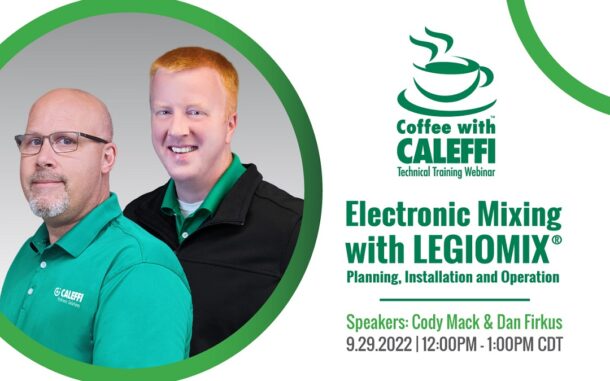
Mack has nearly 20 years’ experience as installation contractor, service technician, application engineer, training manager and now product manager for Caleffi. Our audience will appreciate his thoughtful yet humorous content delivery combined with his practical, common sense product approach.
Firkus has 25 years’ of field experience as an installation contractor plus three years of application engineer experience at Caleffi, assisting wholesalers, engineers and installers. Recently promoted to OEM Sales Manager, his well-rounded and realistic technical background provides a firm foundation for our audience.
The monthly educational webinars are free and are intended for engineers, contractors, designers and wholesalers. A Certificate of Attendance is emailed to attendees following the event for continuing education audits.
Please visit our website at www.caleffi.us for schedule details and registration.
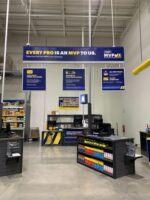
The Lowe’s MVPs Pro Rewards and Partnership Program is a new approach that flips traditional loyalty programs on their heads to deliver real solutions and benefits Pros need to succeed. The new program comes at a time when 90% of Pros say it’s important that retailers have valuable loyalty programs, and according to new findings from Lowe’s, Pros also voiced Read more
The Lowe’s MVPs Pro Rewards and Partnership Program is a new approach that flips traditional loyalty programs on their heads to deliver real solutions and benefits Pros need to succeed. The new program comes at a time when 90% of Pros say it’s important that retailers have valuable loyalty programs, and according to new findings from Lowe’s, Pros also voiced the need for retailers to bring more than rewards to the table.

Lowe’s MVPs Pro Rewards, available in select regions and nationwide gives Pros a committed business partner in Lowe’s. Complementing Lowe’s strong credit offerings (5% off every day on eligible purchases, to 0% interest for 60 days for Lowe’s Business Advantage accounts), Lowe’s MVPs Pro Rewards offers new and existing loyalty members benefits including:
- Lowe’s e-gift cards earned when Pros spend in-store and online on eligible purchases**
- Access to business resources helping Pros tackle back-of-house operations
- Exclusive offers for rewards on eligible paint purchases** and free select snacks or drinks** at Lowe’s stores
- A chance to win incredible prizes like Ford F-Series trucks that serve as many Pros’ mobile offices and custom-built local advertising packages***
- A simple mobile and online user experience allowing Pros to track and claim rewards even when sending a crew member into the store
- And, coming soon, MVPs Bonus Points that can be used for additional exciting rewards helping Pros invest in their businesses and themselves

“We’re deepening our partnership with Pro customers because when they succeed, we succeed,” said Tony Hurst, Senior Vice President Pro, Services and International. “Lowe’s MVPs Pro Rewards is another big step in Lowe’s continued Total Home strategy when it comes to the important Pro customer. We are committed to a true business partnership mindset to help Pros as they grow their businesses and their futures.”
Nearly 90% of Pros say it’s important for retailers to have valuable loyalty programs as Pros also voiced the need for retailers to offer solutions to propel their business forward, according to Lowe’s first annual Lowe’s State of the Pro report, found online at Lowes.com/StateOfThePro. An industry-leading study, the report contains insights from Pros and their customers, detailing the state of the home industry and trends in homeowner improvement plans, and priority projects in 2022.
For more information on the latest for Pros, please visit Lowes.com/Pro.
One of the most noteworthy impacts of the COVID-19 pandemic has been the national labor shortage and the widespread media attention it has earned. According to Newsweek, there were 10.4 million job openings in the United States in September, but fewer than 8 million unemployed workers. That gap has placed enormous stress on the overall Read more
One of the most noteworthy impacts of the COVID-19 pandemic has been the national labor shortage and the widespread media attention it has earned.
According to Newsweek, there were 10.4 million job openings in the United States in September, but fewer than 8 million unemployed workers. That gap has placed enormous stress on the overall economy, from manufacturing and distribution to the retail and service sectors, as suppliers struggle to meet consumer demand.
For those in the skilled trades industries, this story is familiar. They have faced a chronic version of the overall labor shortage for decades.

Demographic challenges and misconceptions
The average age of skilled workers is now 43, according to one estimate from Angi. With fewer young people entering the trades every year, the situation is expected to get worse. The approaching wave of baby boomer retirements will only add to the problem.
For manufacturing, construction, and field service companies, the skilled trades crisis poses major ongoing challenges. It’s hard to maintain productivity and customer service while you’re understaffed or experiencing frequent turnover. Projects are often delayed because workers aren’t available. Revenue is lost for multiple reasons: worker inexperience, inefficiency, long work hours, or jobs that have to be postponed or turned down.
Unfortunately, many high school students and recent graduates who might thrive in the trades never consider a career in those industries. The message that college is the only path to success has become ingrained in our culture in the last 30 years. Despite the rising cost of higher education and the increasing number of students who never earn a degree, the college journey has eclipsed all other options.
In addition to highlighting the labor crisis, recent circumstances have demonstrated that manufacturing, distribution, and residential and commercial service jobs are a critical part of the national economy. These industries played a key role in public health and safety during lockdowns and periods of social distancing and quarantines. Many products and services provided by the HVAC and PHCC industries proved to be essential during the pandemic and have remained critical economic drivers as communities have reopened.
This national spotlight on the essential nature of the trades offers an opportunity to reorient public perception and correct the misconceptions that have contributed to the skilled trades labor gap.

Closing the gap
In response to the growing labor gap, trade organizations have partnered in recent years with vocational schools, employers, manufacturers, and public agencies to promote the trades as a viable alternative to a four-year degree. Their combined efforts are focused on the many immediate advantages offered by a skilled trades career:
- High wages
- On the job or employer-funded training
- Lack of student debt
- Immediate available positions
- A wide variety of vocational options and career trajectories
- Entrepreneurial opportunities
Additionally, advocates and thought leaders are making the case for other long-term strategies that will create a more effective and reliable talent pipeline. Among those ideas is diversification. Many communities have traditionally been underrepresented in the trades; focusing recruitment, outreach, and marketing efforts in those communities can build trust and allow the trades industries to connect with vibrant new pools of talent.

Immediate solutions
Those efforts, however, will take time to pay off. In the meantime, employers are still faced with a labor crisis of historic proportions and the urgent need to operate efficiently in order to remain competitive in this challenging economic climate.
In order to maintain productivity throughout the remainder of the pandemic and during recovery, many employers are looking for immediate solutions. While there is no magic bullet that will compensate for a labor shortage, there are a number of new and emerging tools available that can help companies boost efficiency and productivity so they can continue to deliver results for their customers.
The pandemic has focused a spotlight on the importance of the technology revolution that was already underway among skilled service providers. Some of the major technology trends and developments that have been accelerated by the pandemic and its fallout are:
- Mobile and remote capabilities: As COVID-19 forced many employees across multiple industries to work cohesively without a physical office, technician mobile apps and other remote technologies have become invaluable to commercial contractors of all types. Today, various mobile applications give teams remote work capabilities that weren’t possible a decade ago.
- Modular construction: The modular construction market is seeing an increase in business, which is in response to combined cost-effective construction technology and labor shortages. Modular and offsite construction continues to grow and contribute to less expensive housing and commercial construction. In addition to their convenience, other benefits of modular projects include the ability to more effectively regulate worker safety within ventilated and climate-controlled workspaces. These advantages also further help workers comply with social distancing guidelines.
- Artificial Intelligence: Artificial intelligence (AI) is capable of lowering the cost of construction and service while helping teams successfully plan and schedule projects. AI is frequently used in software to conduct analyses and simulations in a variety of hypothetical situations and environments. In turn, AI is invaluable in developing new safety protocols and minimizing the risk of workplace injuries. Its role is expected to continue to rise in response to the workforce shortage exacerbated by COVID-19 shutdowns.
- Integrated software solutions: The number of contractors who still rely on pencil and paper or spreadsheets for record-keeping and accounting has steadily dwindled over the last decade, and sharply declined during 2020. Simply switching from manual job management to an enterprise solution can generate major gains for most businesses. A single all-in-one platform is critical for efficiency; requiring technicians to move back and forth between multiple apps not only takes up precious work time, it can serve as an obstacle to adoption.
- When actionable data from across departments is collected and accessible in real time, all parties involved in a project benefit. Up-to-the-minute insights and transparent communication empower purposeful, immediate decision-making and fast, accurate execution.
Resolving the labor shortage that has challenged the skilled trades will be a win not only for the industries involved. The long-term strategies currently being deployed will expand the choices available for young people and dismantle the preconceived notion that a college degree is required for success. By opening up opportunities for vocational training and apprenticeships in place of a university program, we can ensure young people are on the right track from the start. Presenting the trades as a viable option could also help reduce the national burden of student debt and alleviate college dropout rates.
In order to find and implement a comprehensive solution, it is imperative that we examine and assess our educational pipeline and deliver an authentic message about the advantages and opportunities of skilled trades careers. Innovation is the key to ensuring America’s workforce is prepared and supported.
For more information on this subject, visit www.buildops.com.

A.O. Smith, a leading water heater manufacturer, has donated 200 water heaters for Waverly, Tenn. flood relief efforts. The units will be provided to flood victims who are still rebuilding eight months after storms ripped through the town on Aug. 21, 2021. “At A. O. Smith, we are deeply committed to supporting our local communities,” Read more
A.O. Smith, a leading water heater manufacturer, has donated 200 water heaters for Waverly, Tenn. flood relief efforts. The units will be provided to flood victims who are still rebuilding eight months after storms ripped through the town on Aug. 21, 2021.
“At A. O. Smith, we are deeply committed to supporting our local communities,” said David Chisolm, vice president of marketing and customer experience. “Hot water is such a basic life necessity. We hope the donation of these units will allow this community to rebuild more quickly while lessening the financial burden. We also hope that this will inspire other companies to step forward with additional donations to assist in rebuilding the Waverly community.”
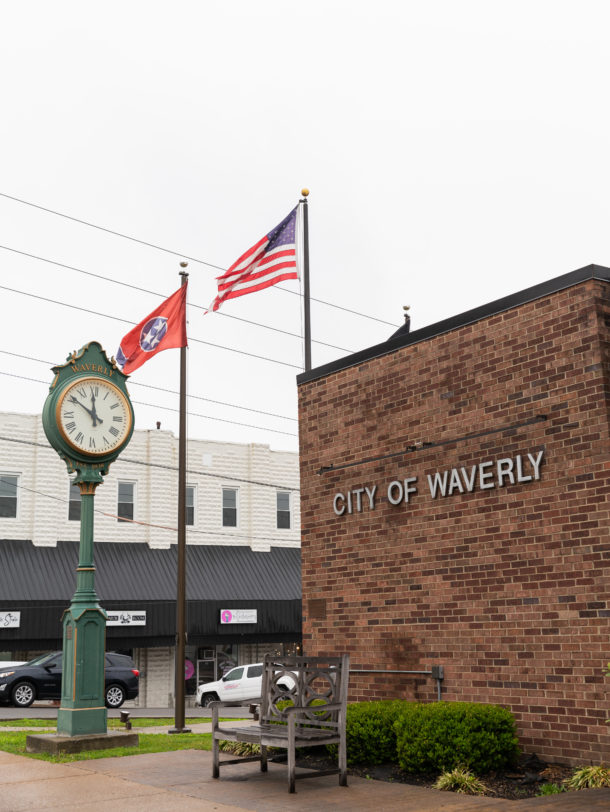
In August 2021, treacherous storms swept through the Waverly community claiming 20 lives, including several children. Hundreds of homes were damaged, and some residents have even had to purchase trailers and RVs to live in while their homes are being repaired. Of the homes that were destroyed or severely damaged, 80% of them are owned by people ages 70 or older, and most of those homeowners are living on social security wages.
“The past eight months since the flood have been incredibly difficult, but Waverly is a resilient town,” said Waverly resident, Susan Hodges. “When our family began rebuilding, we had no idea how long the process would take or just how expensive it would be. We’re grateful for the money we’ve saved by not having to purchase a water heater, but the impact of A. O. Smith’s donation goes beyond that—it’s a huge step toward making our home livable once again, and it’s raised our spirits along the way.”
FEMA helped support the community at the beginning of its redevelopment phase immediately after the flooding, but the extensive damage has continued to put pressure on homeowners. Community members have worked relentlessly to help their neighbors, friends and family in the area recover from the devastation. Hodges has two adult children living in Waverly whose houses were destroyed by the flood. She has spent the last eight months assisting them in their complete home renovations.
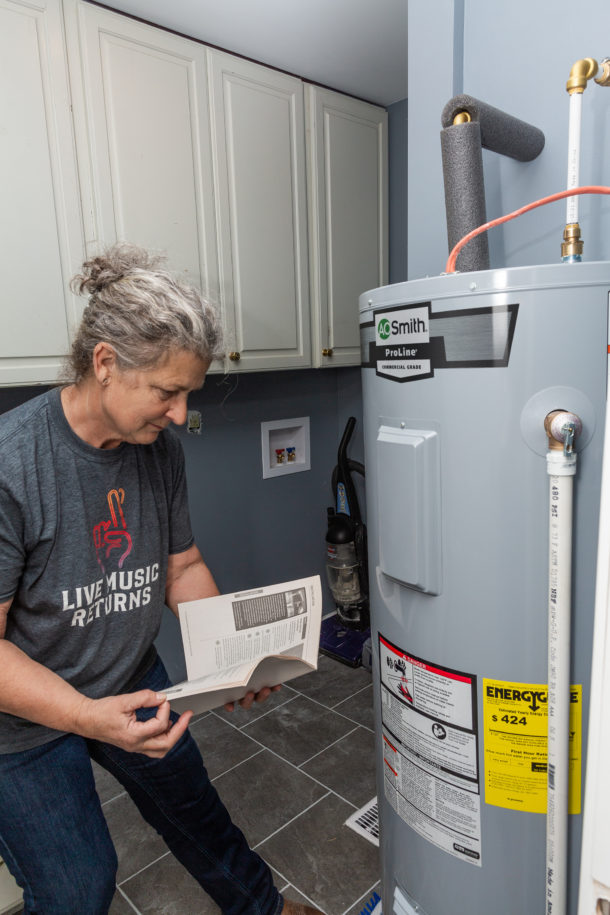
“The Waverly community has worked tirelessly to help neighbors and friends rebuild from this tragedy. We are so thankful for the water heater donation from A. O. Smith,” said Kaye Thomas of First Baptist Church Relief Efforts. “Water heaters are an essential item that many of our homeowners could not afford without the help from A. O. Smith. This donation truly gave the Waverly community a renewed sense of hope in what continues to be a long road to recovery. It will allow our community to continue to push forward in recovery efforts as we rebuild.”
The units were delivered to the First Baptist Church in Waverly earlier this year, and roughly 100 units have already been distributed to families in need. Distribution and installation will continue in the coming months.
